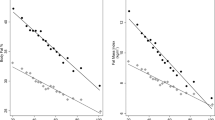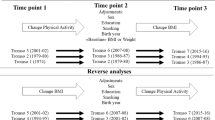Abstract
BACKGROUND:
Increased physical activity is often recommended for weight maintenance and loss.
OBJECTIVE:
To examine how intensity, frequency, and type of recreational physical activity are associated with weight gain attenuation over a 10-y period.
PARTICIPANTS:
Over 15 000 adults between 53 and 57 y living in western Washington State recruited between 2000 and 2002.
MEASUREMENTS:
Self-reported measures of physical activity (using a questionnaire), height, and weight.
METHODS:
We examined associations between physical activity and weight change after age 45 y. All analyses controlled for age at baseline, weight at age 45 y (continuous), diet, education, smoking, and weight change between ages 30 and 45 y, and were stratified by sex and body mass index (BMI) at age 45 y (normal weight, overweight, or obese).
RESULTS:
Increasing MET-hours and sessions per week of high-, moderate- and low-intensity activities over 10 y were inversely related to weight gain after age 45 y. Generally, associations were stronger for women than for men and for obese compared to normal weight or overweight individuals. Obese women and men who participated in 75–100 min per week of fast walking gained 9 and 5 pound less than nonwalkers, respectively, and lesser amounts in normal weight and overweight women and men. Jogging, aerobics, and fast cycling were associated with weight gain attenuation in most sex and age 45 y BMI groups, while slow walking, swimming, and weight lifting were not.
CONCLUSIONS:
In this free-living population, long-term, regular physical activity, particularly common activities carried out at a moderate intensity such as walking, prevented some of the weight gain associated with aging.
This is a preview of subscription content, access via your institution
Access options
Subscribe to this journal
Receive 12 print issues and online access
$259.00 per year
only $21.58 per issue
Buy this article
- Purchase on Springer Link
- Instant access to full article PDF
Prices may be subject to local taxes which are calculated during checkout

Similar content being viewed by others
References
Field AE, Coakley EH, Must A, Spadano JL, Laird N, Dietz WH, Rimm E, Colditz GA . Impact of overweight on the risk of developing common chronic diseases during a 10-year period. Arch Intern Med 2001; 161: 1581–1586.
US Department of Health and Human Services. Physical Activity and Health: A Report of the Surgeon General. US Department of Health and Human Services Center for Disease Control and Prevention, National Center for Chronic Disease Prevention and Health Promotion: Atlanta, GA; 1996. pp 87–102.
Mokdad AH, Ford ES, Bowman BA, Dietz WH, Vinicor F, Bales VS, Marks JS . Prevalence of obesity, diabetes, and obesity-related health risk factors, 2001. JAMA 2003; 289: 76–79.
Willett W . Nutritional Epidemiology. Monographs in Epidemiology and Biostatistics; v. 30, 2nd edn. Oxford University Press: New York; 1998.
DiPietro L . Physical activity in the prevention of obesity: current evidence and research issues. Med Sci Sports Exerc 1999; 31: S542–S546.
Fogelholm M, Kukkonen-Harjula K . Does physical activity prevent weight gain—a systematic review. Obes Rev 2000; 1: 95–111.
Wing RR . Physical activity in the treatment of the adulthood overweight and obesity: current evidence and research issues. Med Sci Sports Exerc 1999; 31: S547–S552.
White E, Patterson RE, Kristal AR, Thornquist M, King I, Shattuck AL, Evans I, Satia-Abouta J, Littman AJ, Potter JD . VITamins And Lifestyle cohort study: study design and characteristics of supplement users. Am J Epidemiol 2004; 159: 83–93.
Expert Panel on the Identification, Evaluation, and Treatment of Obesity in Adults. Clinical guidelines on the identification, evaluation, treatment, and treatment of overweight in adults. Am J Clin Nutr 1998; 68: 899–917.
World Health Organization. Obesity: Preventing and Managing the Global Epidemic: Report of a WHO Consultation, WHO technical report series, 894, World Health Organization, Geneva 2000.
Littman AJ, White E, Kristal AR, Patterson RE, Satia-Abouta J, Potter JD . Assessment of a one-page questionnaire on long-term recreational physical activity. Epidemiology 2004; 15: 105–113.
Ainsworth BE, Haskell WL, Whitt MC, Irwin ML, Swartz AM, Strath SJ, O'Brien WL, Bassett Jr DR, Schmitz KH, Emplaincourt PO, Jacobs Jr DR, Leon AS . Compendium of physical activities: an update of activity codes and MET intensities. Med Sci Sports Exerc 2000; 32: S498–S504.
Taylor HL, Jacobs Jr DR, Schucker B, Knudsen J, Leon AS, Debacker G . A questionnaire for the assessment of leisure time physical activities. J Chronic Dis 1978; 31: 741–755.
Klein EA, Thompson IM, Lippman SM, Goodman PJ, Albanes D, Taylor PR, Coltman C . SELECT: the Selenium and Vitamin E Cancer Prevention Trial: rationale and design. Prostate Cancer Prostatic Dis 2000; 3: 145–151.
Patterson RE, Kristal AR, Tinker LF, Carter RA, Bolton MP, Agurs-Collins T . Measurement characteristics of the Women's Health Initiative food frequency questionnaire. Ann Epidemiol 1999; 9: 178–187.
Erlichman J, Kerbey AL, James WP . Physical activity and its impact on health outcomes. Paper 2: prevention of unhealthy weight gain and obesity by physical activity: an analysis of the evidence. Obes Rev 2002; 3: 273–287.
Votruba SB, Horvitz MA, Schoeller DA . The role of exercise in the treatment of obesity. Nutrition 2000; 16: 179–188.
Rimm EB, Stampfer MJ, Colditz GA, Chute CG, Litin LB, Willett WC . Validity of self-reported waist and hip circumferences in men and women. Epidemiology 1990; 1: 466–473.
Engstrom JL, Paterson SA, Doherty A, Trabulsi M, Speer KL . Accuracy of self-reported height and weight in women: an integrative review of the literature. J Midwifery Womens Health 2003; 48: 338–345.
Olivarius NF, Andreasen AH, Loken J . Accuracy of 1-, 5- and 10-year body weight recall given in a standard questionnaire. Int J Obes Relat Metab Disord 1997; 21: 67–71.
Tamakoshi K, Yatsuya H, Kondo T, Hirano T, Hori Y, Yoshida T, Toyoshima H . The accuracy of long-term recall of past body weight in Japanese adult men. Int J Obes Relat Metab Disord 2003; 27: 247–252.
Armstrong BK, White E, Saracci R . Principles of Exposure Measurement in Epidemiology. Oxford University Press: Oxford; 1994.
Williamson DF . Dietary intake and physical activity as ‘predictors’ of weight gain in observational, prospective studies of adults. Nutr Rev 1996; 54: S101–S109.
Saris WH, Blair SN, van Baak MA, Eaton SB, Davies PS, Di Pietro L, Fogelholm M, Rissanen A, Schoeller D, Swinburn B, Tremblay A, Westerterp KR, Wyatt H . How much physical activity is enough to prevent unhealthy weight gain? Outcome of the IASO 1st Stock Conference and consensus statement. Obes Rev 2003; 4: 101–114.
Wier LT, Ayers GW, Jackson AS, Rossum AC, Poston WS, Foreyt JP . Determining the amount of physical activity needed for long-term weight control. Int J Obes Relat Metab Disord 2001; 25: 613–621.
Ball K, Owen N, Salmon J, Bauman A, Gore CJ . Associations of physical activity with body weight and fat in men and women. Int J Obes Relat Metab Disord 2001; 25: 914–919.
Salmon J, Owen N, Bauman A, Schmitz MK, Booth M . Leisure-time, occupational, and household physical activity among professional, skilled, and less-skilled workers and homemakers. Prev Med 2000; 30: 191–199.
Prentice AM, Black AE, Coward WA, Cole TJ . Energy expenditure in overweight and obese adults in affluent societies: an analysis of 319 doubly-labelled water measurements. Eur J Clin Nutr 1996; 50: 93–97.
Ferro-Luzzi A, Martino L . Obesity and physical activity. Ciba Found Symp 1996; 201: 207–221; discussion 221–222.
Williamson DF, Madans J, Anda RF, Kleinman JC, Kahn HS, Byers T . Recreational physical activity and ten-year weight change in a US national cohort. Int J Obes Relat Metab Disord 1993; 17: 279–286.
Guo SS, Zeller C, Chumlea WC, Siervogel RM . Aging, body composition, and lifestyle: the Fels Longitudinal Study. Am J Clin Nutr 1999; 70: 405–411.
Schmitz KH, Jacobs Jr DR, Leon AS, Schreiner PJ, Sternfeld B . Physical activity and body weight: associations over ten years in the CARDIA study. Coronary Artery Risk Development in Young Adults. Int J Obes Relat Metab Disord 2000; 24: 1475–1487.
American College of Sports Medicine. Appendix D: Metabolic Calculations. ACSM's Guidelines for Exercise Testing and Prescription. Williams & Wilkins: Baltimore, MD; 1985. pp 269–287.
Jakicic JM, Clark K, Coleman E, Donnelly JE, Foreyt J, Melanson E, Volek J, Volpe SL . American College of Sports Medicine position stand. Appropriate intervention strategies for weight loss and prevention of weight regain for adults. Med Sci Sports Exerc 2001; 33: 2145–2156.
Gwinup G . Weight loss without dietary restriction: efficacy of different forms of aerobic exercise. Am J Sports Med 1987; 15: 275–279.
Acknowledgements
This work was supported by Grants R01 CA74846 and R25 CA94880 from the National Cancer Institute. We thank the VITAL participants and staff for making this study possible.
Author information
Authors and Affiliations
Corresponding author
Appendix
Appendix
Details on the proportion of individuals who reported doing various types of physical activities, and the median MET-hours and exercise sessions per week among those who were active are presented in Table A1.
Rights and permissions
About this article
Cite this article
Littman, A., Kristal, A. & White, E. Effects of physical activity intensity, frequency, and activity type on 10-y weight change in middle-aged men and women. Int J Obes 29, 524–533 (2005). https://doi.org/10.1038/sj.ijo.0802886
Received:
Revised:
Accepted:
Published:
Issue Date:
DOI: https://doi.org/10.1038/sj.ijo.0802886
Keywords
This article is cited by
-
RSSDI-ESI Clinical Practice Recommendations for the Management of Type 2 Diabetes Mellitus 2020
International Journal of Diabetes in Developing Countries (2020)
-
Prospective association between body composition, physical activity and energy intake in young adults
European Journal of Clinical Nutrition (2016)
-
Exploring the Effect of Participation in Sports on the Risk of Overweight
Applied Research in Quality of Life (2015)
-
Physical Activity and the Risk of Becoming Overweight or Obese in Middle‐Aged and Older Women
Obesity (2012)
-
Leisure-time physical activity and sedentary behavior clusters and their associations with overweight in middle-aged French adults
International Journal of Obesity (2010)



